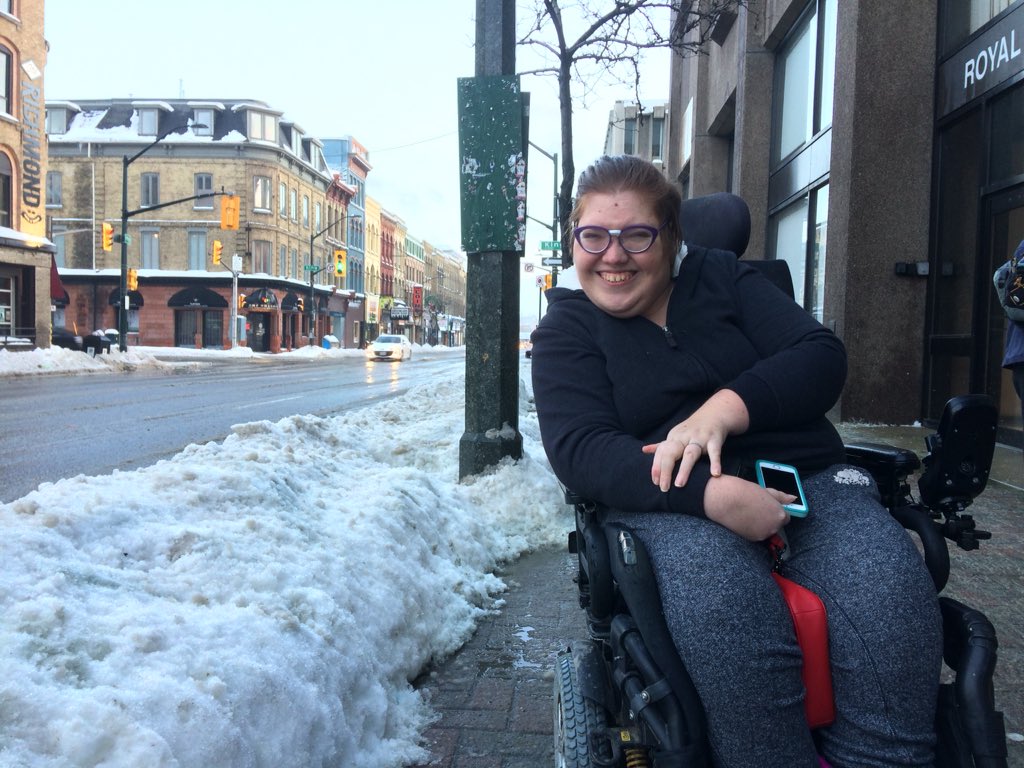“I get stuck a lot,” said Karli Steen, a 26-year-old London woman who has been using a wheelchair to navigate the city her entire life.

When she woke up this morning to thick falling snow, and several centimetres of accumulation, she wondered if the hassle of getting to work would be worth it.
“It’s a dread because sometimes, I really just have to do stuff, and the weather doesn’t comply with my schedule,” she said.
“It feels like you’re trapped, even just looking outside your window.”
Steen grew up in London, and started working at the downtown office for Diply.com, a social news and entertainment website, nearly two years ago. She relies on para-transit, which drops her off and picks her up at her building’s front doors. But on days like Monday — when she tries to get off the specialized bus — she’s greeted by a large snowbank.
“They can hardly get the ramp down,” she said, pointing out it’s not the driver’s job to clear the sidewalk.
“They don’t make wheelchairs with all-season tires, unfortunately. Lots of times, I have to rely on Good Samaritans to help me get unstuck.”
Steen has reached out to the city of London before, speaking with maintenance crews last year about the “dismal conditions.” But the dialogue didn’t leave her feeling satisfied with the city’s approach to snow removal on local sidewalks.
But that doesn’t mean it’s OK for everyone else, she said.
“It’s hard, because I’m just trying to be a contributing member of society, and it’s dependent on the weather.”
The city’s manager of transportation and roadside operations, John Parsons, says there’s a requirement for sidewalks to be cleared 24 hours after the snow ends if there are eight centimetres of accumulation or more. However, he says there are no requirements for sidewalk snow removal by the Accessibility for Ontarians with Disabilities Act.
That’s why disability rights advocate Jeff Preston, is calling on the city to realign its own policies with mobility needs.
“Our crisis often extends well beyond the first day. Do I think that London will be back up and running for most people tomorrow? Absolutely. Will it be back up and running for people with physical mobility disabilities? Probably not.”
Preston also uses a mobility device, and unlike Steen, he didn’t make it into work on Monday — he’s working from home instead.
“In terms of what the city is doing today, I don’t have a ton of complaints. I think the city is doing the best they can with a pile of snow accumulation.”
The problem is that in the days following heavy snow, the access points for sidewalks are blocked by snow from road plows.
“It is not uncommon for me, driving around downtown, to find myself to a relatively clear sidewalk that I can’t get up on because the road plow has blocked the entrance, and the sidewalk plows have not been reached.”
Though he remains hopeful that his voice, among a chorus of others calling for the same thing, will prompt action at city hall — he’s not holding his breath.
“I’m not confident in past experience, that the city is going to dig out for people with disabilities in the same way, and with the same speed and urgency as they dig out for people who don’t have physical disabilities.”








Comments